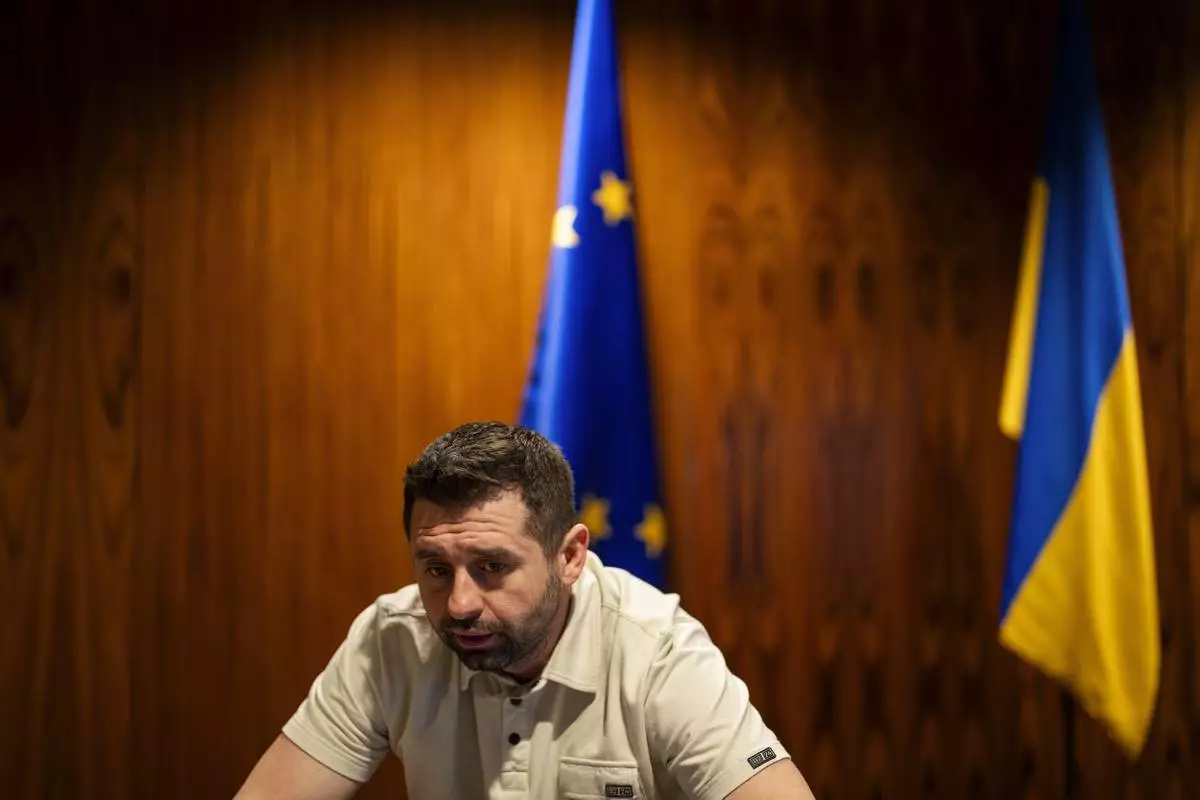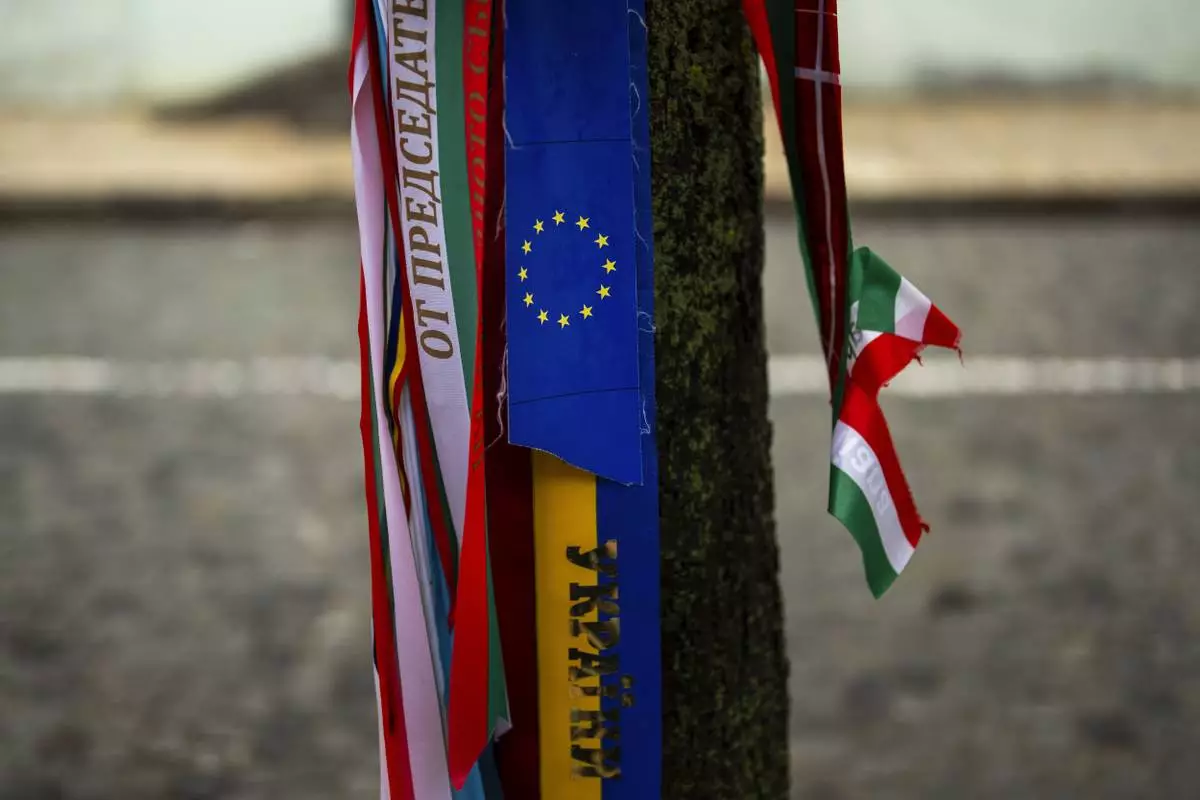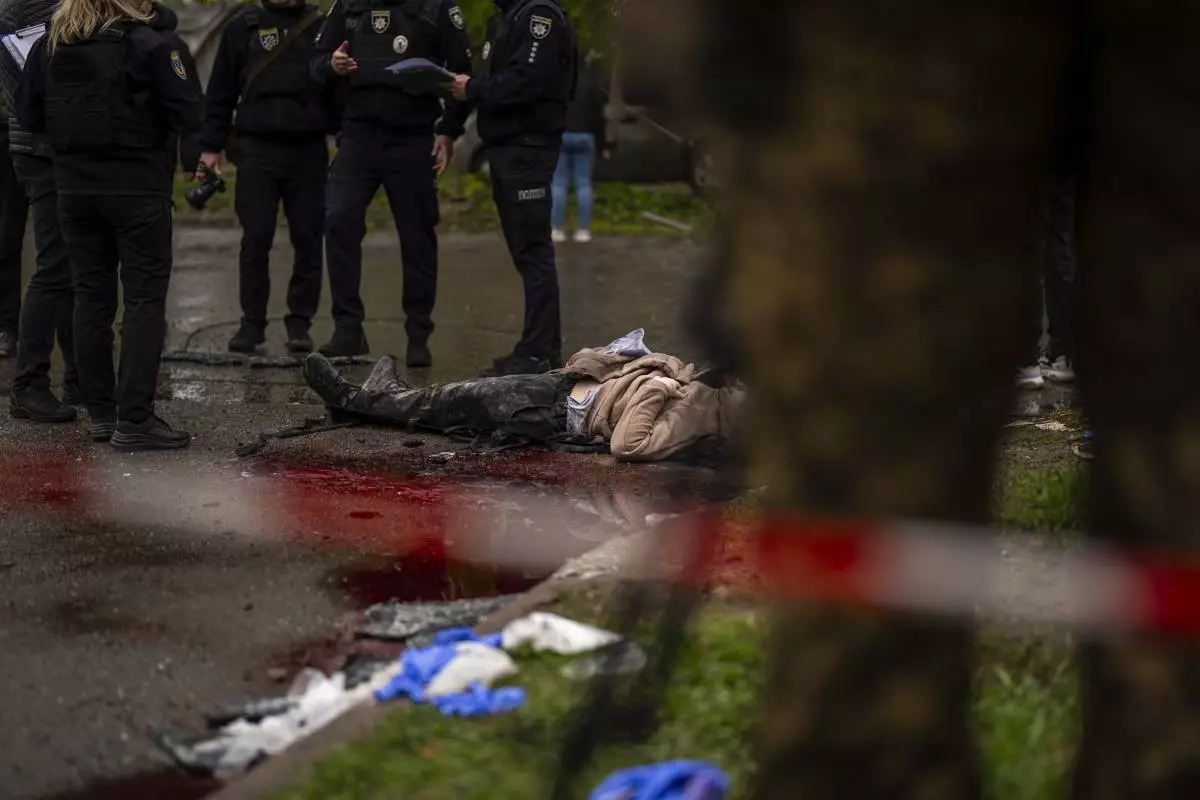Republicans have no unified argument in the impeachment inquiry of Donald Trump , in large part because they can't agree on how best to defend the president — or for some, if they should.
That would require a level of consensus that Trump's call with the Ukraine president was "perfect," as he insists. Or it would take a measure of GOP independence from Trump to suggest there may be a need to investigate.
Instead, it's every Republican for himself or herself.

FILE - In this Oct. 24, 2019, file photo, Sen. Lindsey Graham, R-S.C., speaks during a news conference at the Capitol in Washington. Republicans have no unified argument in the impeachment inquiry of Donald Trump in large part because they can’t agree on how to defend the president. (AP PhotoJ. Scott Applewhite, File)
Utah Sen. Mitt Romney says the president's actions toward Ukraine are "troubling." Other Republicans say the behavior may raise concerns, but it's not impeachable.
South Carolina Sen. Lindsey Graham calls the whole impeachment inquiry "B.S."
The result is a mishmash of GOP commentary spilling from Capitol Hill that may shield lawmakers, for now, from risky political choices, but leaves them with a disjointed defense of Trump as impeachment hearings push into the public realm this coming week.

President Donald Trump waves to supporters after speaking at his Black Voices for Trump rally Friday, Nov. 8, 2019, in Atlanta. (AP PhotoJohn Bazemore)
"It's not good," said veteran GOP strategist Alex Conant. "Normally you want to establish the facts, get them out on their own terms, and build a message around that strategy. They're not doing any of that."
He added: "It's hard to rally people to your side without a coherent and sustainable message."
Early on, as the White House ceded the PR strategy to the president, Republicans in the House and Senate parted ways as they confronted the political threat posed by the Democrats' impeachment investigation.
As far back as mid-October, Senate Majority Leader Mitch McConnell, R-Ky., gathered his GOP colleagues in private and offered them advice on impeachment.
McConnell told Republican senators their best bet was to calibrate their own message about the impeachment inquiry to fit their political situation, according to two people familiar with the private meeting who spoke on condition of anonymity to discuss the closed-door session.
With a Power Point presentation, McConnell outlined the process ahead if the investigation moves to a vote in the House and trial in the Senate. But when it came time to broach what Republicans should say about impeachment, McConnell showed a preference for saying as little about it as possible.
McConnell suggested a couple of options. Senators could say they disagreed with the House process, he said, or they could simply say that as potential jurors in an eventual impeachment trial they wouldn't discuss it, according to the people familiar with the meeting.
It was the kind of political advice one would expect from the risk-averse leader as he tries to insulate his 53-seat GOP majority, including several senators up for reelection in 2020 in states such as Maine and Colorado where voters are split on Trump.
"That's what a good leader does — gives them the flexibility they need to respond. My problem is, given how egregious the president's conduct is, he's given them a pass," said Jim Manley, a veteran Democratic strategist.
"Most of these folks have got to know that what the president's doing is wrong, but they've made a cold-hearted, political decision right now it's best to stick with the president," he said.
At its core, the impeachment inquiry is based on what Democrats say is an improper quid pro quo — a "shakedown" — that Trump engaged in during his July 25 phone call with Ukrainian President Volodymyr Zelesnkiy.
According to a White House rough transcript of the call and testimony from several government officials, Trump was withholding needed military aid the East European ally as he wanted Zelenskiy to investigate Trump's potential 2020 rival, Joe Biden, as well 2016 U.S. election interference.
In the House, where congressional district boundary lines have been drawn in a way that leaves Republicans barely exposed to voters with centrist or left-leaning views, GOP leaders are mounting a more fulsome, if shifting, defense of Trump.
GOP leader Kevin McCarthy of California says the president did nothing wrong on the call with Zelenskiy, and Trump's top allies in the House, including Ohio Rep. Jim Jordan, the top Republican on a committee conducting the impeachment inquiry, are leading the daily arguments against Speaker Nancy Pelosi, D-Calif., and the Democrats.
Jordan is seen as the "chief messenger" for Republicans, said one senior House GOP aide who was not authorized to publicly discuss the strategy and spoke on condition of anonymity.
The House Republican message against impeachment has four distinct parts, according to this aide: The transcript of Trump's call with Zelenskiy shows the president did nothing wrong; several key witnesses testified that they don't have firsthand knowledge of what transpired; the Ukrainians didn't know the military aid was being upheld until it was publicly reported; and eventually the U.S. agreed to send the money to Ukraine.
It's a message being reinforced daily in the media by Jordan and other Trump surrogates, including Reps. Mark Meadows, R-N.C. and Lee Zeldin, R-N.Y., who are also part of the inquiry panels, the person said.
What goes without saying, though, is that few Republicans lawmakers are willing to say the call was "perfect" or that there was "no quid pro quo," as Trump insists.
More often, they say a little of this, a little of that.
"There are perfectly appropriate quid pro quos and there are inappropriate quid pro quos," offered Sen. John Kennedy, R-La. "Just saying that there is a quid pro quo, at least based on my analysis of the evidence that I've seen so far, is a red herring."
Associated Press video journalists Padmananda Rama and Dan Huff in Washington contributed to this report.
KYIV, Ukraine (AP) — A big, new package of U.S. military aid will help Ukraine avoid defeat in its war with Russia. Winning will still be a long slog.
The arms and ammunition in the $61 billion military aid package should enable Ukraine to slow the Russian army's bloody advances and block its strikes on troops and civilians. And it will buy Ukraine time — for long-term planning about how to take back the fifth of the country now under Russian control.
“Ultimately it offers Ukraine the prospect of staying in the war this year,” said Michael Clarke, visiting professor in war studies at King’s College London. “Sometimes in warfare you’ve just got to stay in it. You’ve just got to avoid being rolled over.”
The U.S. House of Representatives approved the package on Saturday after months of delays by some Republicans wary of U.S. involvement overseas. It was passed by the Senate on Tuesday, and President Joe Bidensigned it into law on Wednesday.
The difference could be felt within days on the front line in eastern and southern Ukraine, where Russia’s much larger army has been slowly taking territory against massively outgunned Ukrainian forces.
The aid approval means Ukraine may be able to release artillery ammunition from dwindling stocks that it has been rationing. More equipment will come soon from American stocks in Poland and Germany, and later from the U.S.
The first shipments are expected to arrive by the beginning of next week, said Davyd Arakhamia, a lawmaker with Ukrainian President Volodymyr Zelenskyy’s Servant of the People party.
But opposition lawmaker Vadym Ivchenko, a member of the Ukrainian parliament’s National Security, Defense and Intelligence Committee, said logistical challenges and bureaucracy could delay shipments to Ukraine by two to three months, and it would be even longer before they reach the front line.
While details of the shipments are classified, Ukraine’s most urgent needs are artillery shells to stop Russian troops from advancing, and anti-aircraft missiles to protect people and infrastructure from missiles, drones and bombs.
What’s coming first is not always what front-line commanders need most, said Arakhamia, the Ukrainian lawmaker. He said that even a military giant like the U.S. does not have stockpiles of everything.
“The logic behind this first package was, you (the U.S.) finds our top priorities and then you see what you have in the warehouses,” Arakhamia said. “And sometimes they do not match.”
Hope for future breakthroughs for Ukraine still hangs on more timely deliveries of Western aid, lawmakers acknowledge.
Many experts believe that both Ukraine and Russia are exhausted by two years of war and won’t be able to mount a major offensive — one capable of making big strategic gains — until next year.
Still, Russia is pushing forward at several points along the 1,000-kilometer (600-mile) front, using tanks, wave after wave of infantry troops and satellite-guided gliding bombs to pummel Ukrainian forces. Russia is also hitting power plants and pounding Ukraine’s second-largest city, Kharkiv, which is only about 30 kilometers (some 20 miles) from the Russian border.
Ivchenko said the goal for Ukraine’s forces now is to “hold the line” until the bulk of new supplies arrive by mid-summer. Then, they can focus on trying to recapture territory recently lost in the Donetsk region.
“And probably ... at the end of summer we’ll see some movement, offensive movement of the Ukrainian armed forces,” he said.
Some military experts doubt Ukraine has the resources to mount even small offensives very soon.
The U.S. funding “can probably only help stabilize the Ukrainian position for this year and begin preparations for operations in 2025,” said Matthew Savill, director of military sciences at the Royal United Services Institute, a think tank.
In the best-case scenario for Ukraine, the American aid will give commanders time to reorganize and train its army — applying lessons learned from its failed summer 2023 offensive. It may also galvanize Ukraine’s allies in Europe to increase aid.
“So this just wasn’t about Ukraine and the United States, this really affected our entire 51-country coalition,” said U.S. Congressman Bill Keating, a Democrat who visited Kyiv on Monday as part of a four-member congressional delegation.
Zelenskyy insists Ukraine's war aim is to recapture all its territory from Russia — including Crimea, seized illegally in 2014. Even if the war ultimately ends through negotiation, as many experts believe, Ukraine wants to do that from as strong a position as possible.
Whatever happens on the battlefield, Ukraine still faces variables beyond its control.
Former U.S. President Donald Trump, who seeks to retake the White House in the November election, has said he would end the war within days of taking office. And the 27-nation Europe Union includes leaders like Hungarian Prime Minister Viktor Orbán and Slovak Prime Minister Robert Fico, who have opposed arming Ukraine.
Ukraine’s allies have held back from supplying some arms out of concern about escalation or depleting their own stocks. Ukraine says that to win the war it needs longer-range missiles it could use for potentially game-changing operations such as cutting off occupied Crimea, where's Russia's Black Sea fleet is based.
Ukraine especially wants a longer-range version of Army Tactical Missile Systems, known as ATACMS, from the U.S., along with Taurus cruise missiles from Germany. Both governments have resisted calls to send them because they are capable of striking targets deep within Russian territory.
The new bill authorizes Biden to send Ukraine ATACMS that have a range of some 300 kilometers (190 miles) “as soon as practicable.”
On Wednesday, American officials revealed that the U.S. already secretly transferred a number of the longer-range missiles to Ukraine last month, and they were used for the first time last week to strike an airfield in occupied Crimea. The officials spoke on condition of anonymity to discuss the delivery before it became public.
Meanwhile, Russia is using its advantage in troops and weapons to push back Ukrainian forces, perhaps seeking to make maximum gains before Ukraine's new supplies arrive.
For weeks it has pummeled the small eastern city of Chasiv Yar, suffering heavy losses. Britain's Ministry of Defense says 900 Russian troops are being killed or injured a day in the war.
Capturing the strategically important hill town would allow them to move toward Sloviansk and Kramatorsk, key cities Ukraine controls in the eastern region of Donetsk. It would be a significant win for Russian President Vladimir Putin, who Western officials say is bent on toppling Ukraine’s pro-Western government.
Russian pressure was aimed not just at gaining territory, but on undermining Zelenskyy and bolstering critics who say his war plan is failing, said Clarke of King's College London.
The U.S. aid package decreases the likelihood of a political crisis in Ukraine, and U.S. Speaker Mike Johnson deserves credit for pushing it through Congress, he said.
"He held history in his hands,” Clarke said.
This story has been updated to correct Orbán's title, the Slovak prime minister's name and that the British estimate of daily Russian losses is for the war, not one battle.
Associated Press writers Lolita C. Baldor and Tara Copp contributed from Washgington.
Follow AP’s coverage of the war in Ukraine at https://apnews.com/hub/russia-ukraine

From left, U.S. representatives Nathaniel Moran, R-Tx, Tom Kean Jr, R-NJ, Bill Keating, D-Mass, and Madeleine Deane, D-Pa, talk to journalists during a joint news conference outside Saint Michael cathedral in Kyiv, Ukraine, Monday, April 22, 2024. A newly approved package of $61 billion in U.S. aid may prevent Ukraine from losing its war against Russia. But winning it will be a long slog. (AP Photo/Francisco Seco)

A volunteer makes a camouflage net at a facility producing material for Ukrainian soldiers in Kyiv, Ukraine, Monday, April 22, 2024. A newly approved package of $61 billion in U.S. aid may prevent Ukraine from losing its war against Russia. But winning it will be a long slog. (AP Photo/Francisco Seco)

Davyd Arakhamia, a lawmaker with Ukrainian President Volodymyr Zelenskyy's Servant of the People party, talks during an interview with Associated Press in Kyiv, Ukraine, Monday, April 22, 2024. (AP Photo/Francisco Seco)

A woman rallies to raise awareness on the fate of Ukrainian prisoners of war in Kyiv, Ukraine, Sunday, April 21, 2024. (AP Photo/Francisco Seco)

Ribbons with the colors of the European Union and Ukraine are attached to a tree next to memorial wall of Ukrainian soldiers killed during the war in Kyiv, Ukraine, Monday, April 22, 2024. (AP Photo/Francisco Seco)

The body of a woman killed by Russian bombardment in Chernihiv, Ukraine, Wednesday, April 17, 2024. (AP Photo/Francisco Seco)

Soldiers carry the coffins of two Ukrainian army sergeants during their funeral in Lviv, Ukraine, Tuesday, April 16, 2024. (AP Photo/Francisco Seco)


















